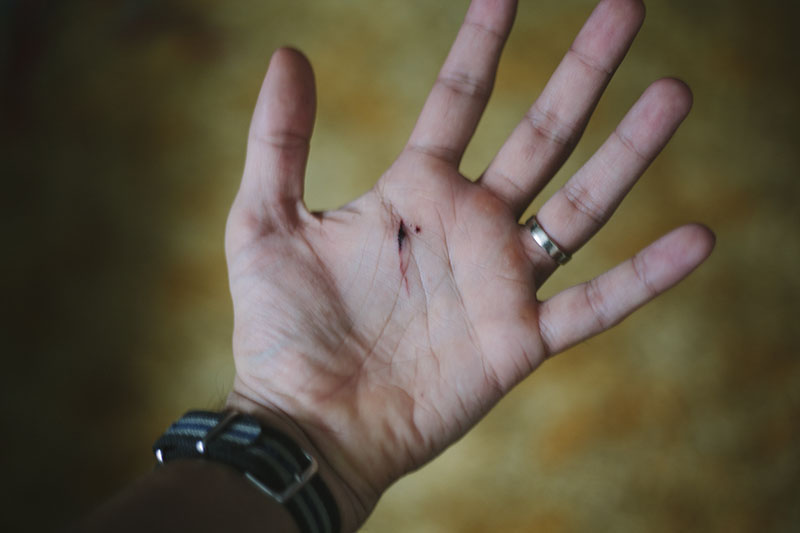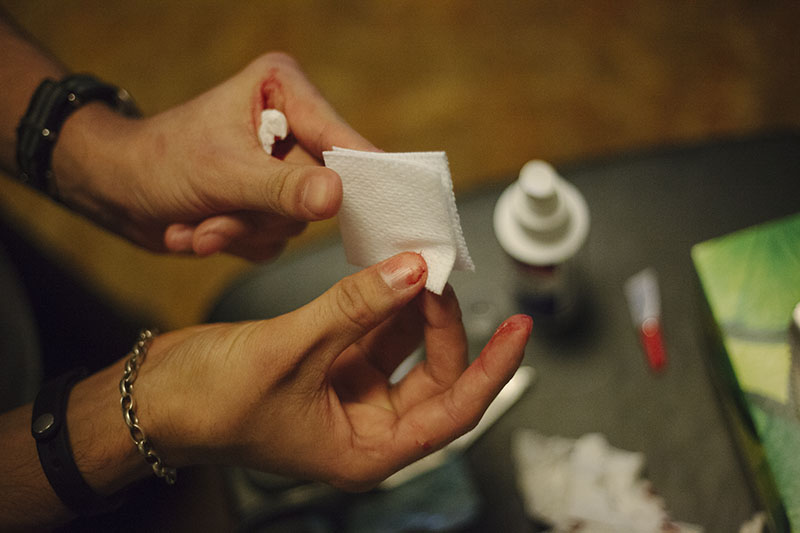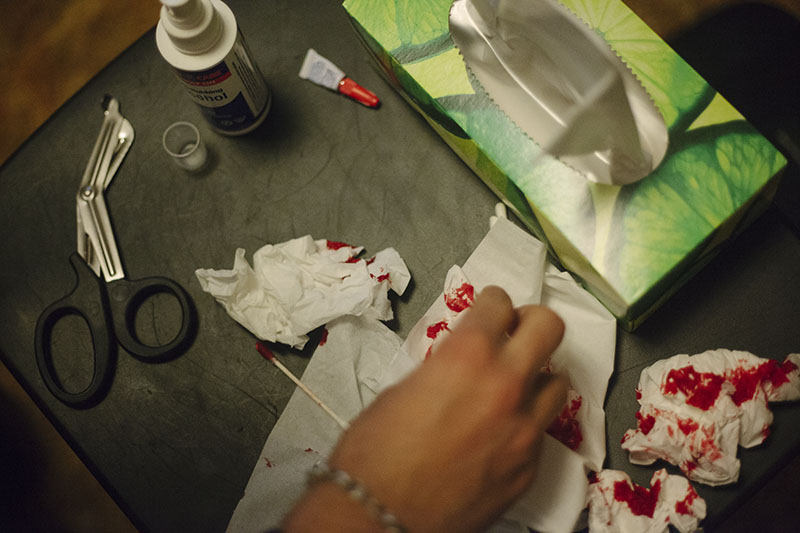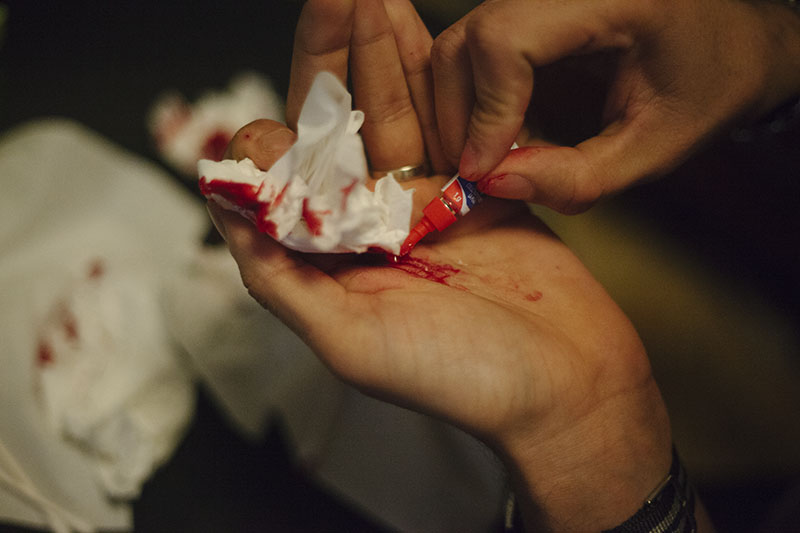I recently cut myself pretty deep on the inside of my palm, and even though the cut healed up relatively well and cleanly, I did notice some bruising around the wound channel as it healed. I realized how messed up my wound looked, mostly considering it was a pretty large and reasonably deep cut in the first place, so I figured it would be a good time to sit down and do some serious research on infections, necrosis, and bruising to be sure that nothing was wrong with my own cut. Here are my findings.

When you initially cut yourself, your body responds aggressively by flooding the area with platelets (the part of your blood that helps your blood to clot). These platelets then start doing the work of helping your blood clot up around the cut to form a protective barrier and to stop blood from continuing to flow out.
When your blood clots up, the clot itself is comprised of lots of different blood cells, as well as fibrin, which is a thread-like substance designed to hold the clot together. If your body is doing its job, a scab over your cut will be formed. The purpose of the scab is to protect the wound from harmful bacteria and the elements. Without the scab, your blood would be exposed to the world, and would essentially be a means by which any dangerous and harmful bacteria could enter your body and cause you to have an infection or get sick.
Generally scabs looks like a hard, brown crust, but with time, scabs naturally fall off revealing new skin and scar tissue. You’ll likely already know this considering it’s unlikely you have made it this far in life without having a scraped knee or little cut before.
Unfortunately, while that clotted layer of blood is supposed to protect your body against bad bacteria, sometimes things don’t play out so well, and your wound ends up getting infected. The infection can happen either because the object that cut you had harmful bacteria on it, or because before the wound was fully clotted to create the scab, environmental factors like some dirt got in the way and infected the blood with bad bacteria before it had a chance to be kept out.
This is why the first aid practice of spraying a wound with a disinfectant (alcohol works) and then covering a wound with a bandage is especially helpful. Spraying the wound with a disinfectant will kill off bad bacteria, and bandaging a wound covers it to prevent new bacteria from touching the cut or laceration until it’s had enough time to properly cut and scab over.

The first sign of an infection is redness and swelling around the wound channel. Also, while cuts and scrapes do hurt, if you have an infection you may also notice more more discomfort and/or pain around the wound than you would normally feel.
If an infection is left untreated, it can get progressively worse, causing major trauma around the wound and surrounding tissue. In time, with an untreated infection, your body will generate pus (a white or yellow liquid) at the site of the infection, and possibly even blistering as well, in cases of more extreme swelling and infection. If the infection gets bad enough you might even see red lines running from the wound towards your heart – the sign of a condition called septicemia. Letting things get to this point is incredibly dangerous, and can kill you. If you are here because you Googled “How to tell if your cut is getting infected,” and you have these symptoms: call 911 (or whatever the equivalent is in your country). Do it immediately.
Septicemia occurs when the infection that has contaminated your blood starts to poison it. While this condition is pretty much one of the worst things that can happen from a cut, it’s not the only life-threatening condition that can occur from an infected wound. Toxic shock, staph infections, and gangrene are all also possible outcomes of a cut infection gone terribly bad. So make sure you take care of your wounds! And certainly do not ignore pain or serious discomfort of a laceration – get that thing checked out if you’re even remotely near concerned. Infection is no joke and a visit to the hospital to check to make sure everything’s okay really could save your life.

To make this lesson on cuts, wounds, and infections exponentially clear, I’ll break things down into some nice bullet points:
What to Do If You Cut Yourself
Learn how to properly clean a cut, scrape, or wound from this article; though if you’d like an abridged version –
- Let’s say it’s a pretty big cut – not just some small paper cut. Probably happened because you were playing with your Kershaw Cryo instead of taking the garbage out like the Mrs. asked you to do 20 minutes ago.
- You start bleeding. At this point, immediately irrigate (wash) the wound with soap and water (yes, you need soap and not just water – remember you need to make sure none of that bad bacteria gets to your blood).
- If you see dirt or debris in the wound remove it using tweezers cleaned with alcohol.
- Locate an antibiotic (like Neosporin or Polysporin), and apply it as a thin layer. For some people this causes a rash – if that happens, obviously stop.
- Figure out whether to use stitches, bandages, or super glue. Get stitches for really deep wounds. Butterfly tape or adhesive strips are fine for minor cuts, but for serious ones I strongly recommend going old school with surgical thread. For small cuts I use superglue, as it’s effective and safe. And bandages are also an option for small cuts if you’ve got no super glue on you.
- Change dressing regularly and watch for signs of infection.
- Keep in mind, if you haven’t had a tetanus shot in the past 5 years you may need a booster shot.
Looking for Signs of an Infection
- Swelling or redness around the wound.
- Warmth around the affected area.
- Increased pain beyond what can realistically be expected from a wound of that type.
- Drainage of pus.
Signs You Need a Hospital Now
- Red lines leading away from the wound towards your heart.
- Necrosis of the flesh. This means that the flesh around the wound has died. Look out for black tissue and a funky smell.
- Sudden fever coupled with aches, diarrhea, nausea, rash, and vomiting. These could be the symptoms of toxic shock.

Don’t take chances with your health. While in most cases the body will do a good job of keeping out bacteria simply by flooding the area of the cut with platelets that will then clot up your blood and create a scab, in some cases, the body can’t prevent a problem from occurring. If the object that cut you in the first place had some bad bacteria, or if some dirt or grime got onto your cut after you began bleeding and had some of that bad bacteria, your cut will get infected. And an infection isn’t always something you can just leave to your immune system and sleep off.
So do yourself a favour. Make sure to take preventive measures before the cut gets infected if you possibly can (spray disinfectant/alcohol on it, bandage it up – keep that thing clean!), and be absolutely sure if you notice any signs of infection, to get that cut checked out straight away! Your life could actually depend on it.
More First Aid Resources
When it comes to first aid, you need two important things to help you on your quest to keep yourself and those around you safe & healthy: knowledge and (to a lesser extent) supplies. To tackle the prior, take a look through our list of the top 22 emergency & survival first aid books and grab those that you think will best help you gain the knowledge you’ll need. For the latter, take a look at our Ultimate First Aid Supplies List to see if there’s anything you should be adding to your at-home first aid supplies stockpile, or if there’s something you’ve forgotten to add to one of your first aid kits.
Do you know what the maximum recommended doses of common painkillers are, whether to use Advil, Tylenol, or Aspirin, and how to quickly assess and address emergency situations? Did you know you can superglue cuts and that Imodium is an excellent tool for survival?
If you have some time, you can quickly browse through all first aid articles published on this blog here, to see if there’s anything valuable you’ve yet to learn on the topics we’ve written about.
I woke up with a small scratch on my legg. and was to much pain to the touch. I washed it with anti bakteria soap. but for the last 3 days it trys to form a scab instead of a thin layer that’s red and that’s it. and a very small under it when touched. does this meen there is a hiden infection deep in the skin.
For liability reasons I have to tell you to go to the doctors, because it *could* be an infection but personally- I doubt it. Sounds pretty standard to me- especially if its a small scratch and you cleaned it out properly.
Thanks for this informative article
My question is suppose a self harm wound in a finger caused infection ,the same was treated but now the palm and wrist seems infected.
Is it possible to get infections of palm and wrist go undetected earlier and if so is it possible that these new found infection in palm and wrist can only be escaped by using prosthetic arm
i have a self harm scar where i can see my veins, is this normal
Scar tissue can be quite thin until new epidermis can grow over it, that said, please seek help. You are not alone in this mate.
S.A.F.E. Alternatives (Self-Abuse Finally Ends)
Information Line: 1-800-DONT-CUT or 1-800-366-8288
Email: info@selfinjury.com
http://www.selfinjury.com
I wish you all the best.
I have these yellow scaly skin around the bottom of my elbow. Some liquid with a hint a white is forming above it and some redness is showing around it. My mom says it’s not that bad and just put some medication on it but I’m still wary. Can you tell me if it is serious and I need to go to my doctor? According to my mom it’s just a simple infection and I’m putting QV cream/lotion on it. It’s working on my left but not my right.
Rinrin, if you suspect that there could be a complication, then go to a doctor. Best case scenario is your mom was right- but just in case it could lead to a more serious issue, its best to have it checked out.
I’m more or so looking for advice, I did a salabrasion technique for tattoo removal on my ankle and I’m very worried it’ll get infected. It has somewhat started to scab over which is good, but it’s kind of sore around the area but no bruising or anything of that matter. No pus has occurred and I have my fingers crossed that it won’t occur. It’s been about 4 days after I inflicted this on myself, I’ve been in the ocean twice since then and I feel like that may have messed with the healing even though right when I got back up to my room I cleaned the area. No discharge has been coming out of the wound and the rest of my leg/ foot feels fine. I’ve been putting neosporin on it and covering it up with a bandaid, the wound is about the size of a quarter and other than sea water it hasn’t been exposed to anything. I’m trying to avoid going to the doctor or bringing it up with my family.
The thing is Jenna, I cannot give you medical advice beyond “seek professional help”. Too many variables and the risk of liability is too high. :( I really wish I could help but sadly I cannot.
How about a tetnus shot.That would eleminate a lot of problems to begin with.They last 10 years and if you go to a doctor 1of the first things they will do is give you a shot.
Definitely a worthwhile suggestion.
One thing I think worth mentioning is cut prevention, i.e. use of gloves, safe handling/cutting techniques, etc
I actually did a blog post last month on hand safety in the wild where I commented on the general lack of emphasis of using gloves when using knives (I personally use very thin and comfortable goatskin, Kevlar-lined drivers with a lvl 4 ANSI cut resistance). With the right gloves you can maintain much of your tactile awareness even with fine tasks.
There are several preferable cutting, slicing, and chopping techniques that keep your body parts out of the “line of fire” -such as driving your knife into a stump with the edge away from you and drawing the stick you are feathering towards you. It takes practice, but you will perform like you practice so if you are wreckless in your backyard you will most likely be that way in the wild.
The more remote you are, the more severe even the slightest cut becomes due to the potential delay in proper treatment against infection, so developing good habits and practices when using edged implements goes a LONG way in sidestepping disaster.
An ounce of prevention and all that.
Yup, commonsense and prevention techniques will eliminate 99% of problems. With that said, I don’t wear gloves when working with blades. I trust my hands more and I feel safer after so many years holding a blade with my fingers firmly gripping the handle.
I often feel when I wear gloves,that when it starts “to give”, I often don’t feel it as quickly as if my hands were connected skin to metal.
My 2c.
so if you have a cut just towards your right side of your plam and its fairly deep(5-8cm) should you go and get it checked
I assume you mean 5-8cm long, cos if thats depth then you don’t have a hand left to worry about! ;)
With regards to getting it checked- if it looks bad in terms of infection and/or risk then yes. I would get it checked- I use superglue immediately after a cut which limits this risk (full bond protects the wound from my enviroment) but I would always be cautious rather than optimistic.
How big of a cut/scrap are we talking about??
It depends on location- if its in an area that will see a lot of movement then superglue might not hold. I have used it on pretty large cuts (1″ long with a depth of .3″) which isn’t recommended but it worked out fine for me. Your mileage may vary of course!
Xavier I so know what to get you for the holidays next year. A case of QuickClot.
Haha, its pretty awesome stuff right? Although contrary to popular belief (and what Elise might say) I don’t cut myself THAT much!
I’m really enjoying your site :) But I can’t help myself—I have to butt in with a correction.
Red lines leading from an injury towards the trunk of the body aren’t a sign of septicemia. It’s a symptom of lympadenitis (also called lymphangitis), a condition where the infection and resulting immune response is causing inflammation of the lymph vessels.
I remember being told as a kid that if those red lines reach your heart, you’ll die. This isn’t true (they can’t reach the heart, as lymphatic drainage occurs a bit upsteam), and it’s not immediately life-threatening, but it’s a darn good indicator that you need to see a doctor ASAP, because it *can* develop quite quickly into bacteremia (presence of bacteria in the blood) and from there to septicemia, so it absolutely requires immediate medical attention, because septicemia is *brutal*.
Septicemia is defined as the presence of actively dividing (growing) bacteria in the blood—in other words, the immune system has been overwhelmed, the bacterial infection is so large and/or strong that the natural immune response (as well as whatever treatment has been thrown at it so far) can’t cope with it. It’s a systemic condition—it affects the major organ systems, you have a raging fever, your thinking is altered, lots of things are going wrong all at once, and it takes a lot of work by a lot of medical professionals to stand a chance of surviving it. (Which is why I know so much about it—-more than a few septicemia sufferers have ended up on my embalming table, and they are immediately recognizable.)
If you’ve got an injury you’re trying to heal, good nutrition is really important, as is completely abstaining from alcohol. And if you’ve got circulatory problems, diabetes, are taking steroid medications (including steroid inhalers for asthma), or any hardcore drug therapies that could interfere with your own immune responses, even the smallest injuries need to be brought to your doctor’s attention, because all of these make it WAY more likely that your celery-chopping accident ends up with me dragging my butt out out of bed at 3 in the morning to give you a ride in my van.
And seriously, none of us want that to happen ;)
Some excellent information there, I will edit the article as appropriate as soon as possible. I really love readers like yourself who share their experiences & knowledge with the community!
Discovered your site through EveryDayCarry and the twitterverse… in response to my follow there you suggested I read and comment on this site. Comments may be slow incoming as you’ve got a lot of good stuff to read! :-) Seriously: nicely done. I look forward to parsing my way through and enjoying much more!
Glad you found our site, Stuart! Looking forward to seeing all the comments roll in as you read through! :) Hope you enjoy!
Hi, such a good post! This could come in very handy.
Thanx. Have a nice day, kind regards, Mijntje.
Thanks dropping by Jasmijn!
Ok..this was good.. Thank You Thomas..well done.
Now i can see why Elise confiscates your knives when You go into uber testing mode; but in your defense “playing with the edges” is a necessity in knowing what edged tools can do.
I have a comment and i am not an MD, but there was a plant named after an Ancient Greek Hero, Achilles. When sword bitten, his troopers had their wounds packed with ‘Achillea Millefolium’. This is Tansy. I have used this on myself before, and here in the Cdn. Prairie it is widespread. It does a great job in staunching bleeding and has antibacterial properties. It is absorbent and soaks everything up. Like tiny cotton balls.
Having said that, I keep Elastoplast and Polysporin with me on weekend outings, however this plant has been very helpful when i was not so prepared..
The Cree Indians out here call it ‘little brother’, and it is has the property of bringing down fever that i have witnessed that was quite unexpectedly effective. Another idea..
I should say, the name is Yarrow, the tansy i quoted before is not correct, a regional misnomer here and points to a different plant, the scientific name is correct..sorry..
Never heard of that plant before, these herbal medicines seem to pack a punch. I gotta do some more research!
Excellent article! Thank you!
Thanks Ginger!
Great website! Lots of good, practical and common sense information!
Thank you! Glad you appreciate it!
Very detailed and very good article. Lots of time requiring effort.
I am 63 and my fear is about how brain cells damage to produce dementia and how to prevent it.
Thank you.
Dementia is truly horrifying, I agree.
Hopefully science will catch up and we can have a cure sometime soon.